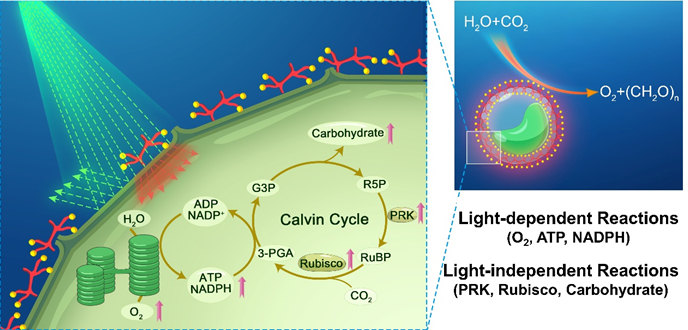Light-harvesting Polymers Augment Plant Photosynthesis by Regulating State Transition of Photosystem
In nature, photosynthetic organisms thrive across a broad range of light intensities due to a self-regulating mechanism of state transition between photosystem I (PSI) and photosystem II (PSII), which allows a well-balanced excitation energy distribution and improves the efficiency of light energy utilization. Artificial regulation of state transition will be a smart and promising way to improve efficiency of natural photosynthesis.
Recently, Professor WANG Shu and his PhD student Xin Zhou from Institute of Chemistry, Chinese Academy of Sciences collaborated with researchers from Institute of Botany, Chinese Academy of Sciences to use light-harvesting polymer PBF to synergistically improve PSI and PSII activities through regulating state transition, resulting in accelerated both light-dependent and light-independent reactions and augmented photosynthesis. Researchers cultured algae Chlorella pyrenoidosa (C. pyrenoidosa) in the medium with the addition of PBF. PBF could wrapped around C. pyrenoidosa through electrostatic and hydrophobic interactions. PBF with green light absorption and far-red emission obviously improved the activity of PSI after enveloping C. pyrenoidosa. Researchers subsequently found that the ability of PSII to capture light was also improved and the activity was increased to match that of the PSI. As a result, PBF enhanced the overall performance of light-dependent reaction. The oxygen evolution and the ATP and NADPH contents were significantly increased. As the source of energy and reducing power for light-independent reaction, the increase of ATP and NADPH was beneficial to the acceleration of light-independent reaction. Cultured with PBF, the growth of C. pyrenoidosa was accelerated and the total biomass was significantly increased. Furthermore, researchers extended the experimental subject from lower plant green algae to higher plants. They dissolved PBF in the nutrient solution of Arabidopsis thaliana (A. thaliana) and found that PBF could be absorbed by the roots to speed up cell mitosis and enhance photosynthesis, ultimately promoting plants growth and flowering. “With excellent harvesting ability, water solubility, and biocompatibility, synthetic polymer materials show promising potential applications for biofuel production, as well as for future energy and environmental development.” Prof. WANG Shu says.
The work entitled “Artificial regulation of state transition for augmenting plant photosynthesis using synthetic light-harvesting polymer materials” was published in Science Advances (DOI: 10.1126/sciadv.abc5237)
The research work was financially supported by the National Natural Science Foundation of China and Strategic Priority Research Program of the Chinese Academy of Sciences.

Schematic diagram of PBF augmented the photosynthesis of C. pyrenoidosa (Image by Prof. WANG Shu)
Contact:
Prof. WANG Shu
Institute of Chemistry, Chinese Academy of Sciences
Email: wangshu@iccas.ac.cn





